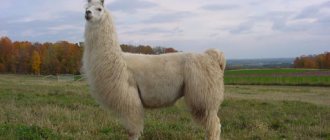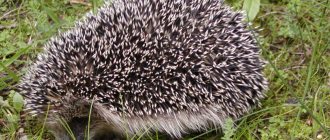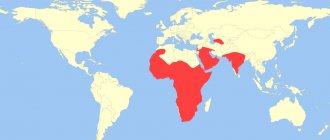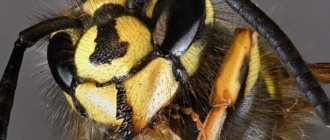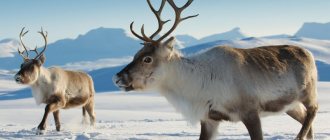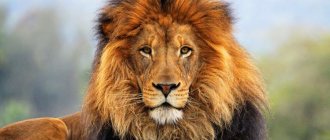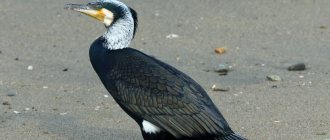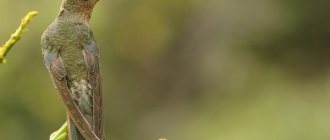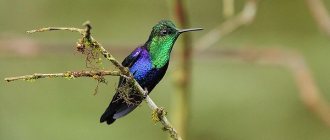- Antler
The antlered deer has taken a strong place both in human mythology and in various everyday jokes, because it is generally accepted to compare a man whose wife is cheating on him with a deer, or rather its antlers. This is obviously connected with the fact that when in the old days men went hunting (including deer), their wives met with lovers at that time, hence the expression “set antlers.” On the other hand, among Indian tribes, deer is considered a sacred animal. “If you meet a sacred deer in the forest, happiness and good fortune await you,” as many Indian legends say. And, of course, killing a deer was a grave crime for the American Indians, which, unfortunately, cannot be said about white people.
Origin of the species and description
The first ancestors of deer appeared during the Eocene period, approximately 56 million years ago.
They did not have horns, but their upper jaws were equipped with tusks. Outwardly, the creatures looked like antelopes. Over the course of 30 million years of evolution, they became larger and spread throughout the planet. Horns appeared on their heads. During the Pliocene, several species of deer already existed, united in a single family - Cervidae. Interesting fact : in the Pleistocene there lived a species of deer that grew up to 2 m in length, and the height of their antlers could reach 4 m.
The most ancient species currently existing is considered to be the reindeer. It appeared about 1.5 million years ago, inhabiting the territories where the United States and Canada are now located.
Video
And finally, an interesting documentary about reindeer.
Author: Pavel Chaika, editor-in-chief of Poznavaika magazine
When writing the article, I tried to make it as interesting, useful and high-quality as possible. I would be grateful for any feedback and constructive criticism in the form of comments on the article. You can also write your wish/question/suggestion to my email [email protected] or Facebook, with respect, the author.
Author page
This article is available in English -
Deer.
Appearance
Most species have a massive body with thin but muscular limbs. The head is supported by a long neck. The deer's head is elongated; at its end there is a black nose, which gradually turns into the upper lip. The eyes are set wide, at the base of the forehead.
Deer head close up
Interesting fact : the age of a deer can be determined by its teeth. Gradually they become more crooked, and by the angle of inclination a zoologist is able to understand how old an individual is.
Males have long ornate horns above their ears, which have a thickened base and pointed ends. Their length can reach up to a meter. Females do not have them. The body color is brown, depending on the species it may have a certain shade and white spots.
Main food for reindeer in winter
But still, the main food for reindeer is reindeer moss.
It is moss that is best to feed reindeer. This moss is the main mineral plant food for deer.
The minerals contained in moss moss (Icelandic moss) have an exceptionally good effect on the production of offspring in female reindeer. In males, horns grow well from reindeer moss, and for this reason, inflammatory processes are not observed during the growth of horns.
Photo: moss is of very high quality and good food for reindeer!
What does it eat?
Deer eats berries
Deer is a herbivore whose diet depends on the season and species. During the period from March to June, it prefers legumes and cereals. In the warm season, it eats berries, mushrooms, seeds, nuts and various fruits. Also, the deer does not mind eating buds, leaves and bushes.
With the onset of cold weather, the deer's diet changes significantly. The animal eats branches and bark of coniferous trees. To restore protein in the body, he periodically eats bird eggs. The lack of minerals and salts is compensated by chewing the earth and drinking water from springs.
Spectrum of deer food
When feeding reindeer in the park area, a large variety of trees, shrubs and grass are used, and of course, reindeer moss (Icelandic moss).
They eat quite a lot of vegetation and the supply of grass and branches should always be quite large. If there is not enough protein in the grass, reindeer begin to eat various wild mushrooms growing in the perimeter of the park, eggs of ground-nesting birds and small rodents - lemmings.
To maintain a special mineral composition, reindeer visit places where salt licks emerge from the ground. If there are no such places in captivity, then it is necessary to place several containers with rock salt so that the reindeer always correct their composition of minerals in the blood.
They also need bone meal and chalk for the same reason. But the main food of reindeer is reindeer moss.
Photo – reindeer food – moss (moss).
For reference, the daily diet of reindeer is fifty percent branches, the same amount of hay or meadow grass.
Many zoos, in order not to purchase rather expensive hay, use bran, oats, wheat or black bread to feed reindeer.
In such cases, as mentioned earlier, it is mandatory to add sea or table salt, chalk and bone meal to the deer’s diet.
Lifestyle
Deer live in different areas, depending on the vegetation.
Most deer live in herds. They gradually wander to different territories, in search of food and favorable conditions. The animal is more active during the day and can cover long distances in a day. The running speed of a deer varies from 50 to 80 km/h, depending on the species.
Interesting fact : in winter, the animal roams in areas where there are many trees, since snow blizzards rarely occur there and there are no large snowdrifts.
general characteristics
Deer are herbivorous, ruminant, artiodactyl mammals from the deer family. There are several dozen species and subspecies of animals in the group. The largest representatives are moose; the body length of a mature male can reach three meters, and the body weight is 650–700 kg. The smallest deer are the pudu, the body length of an adult is no more than 1 meter, and all do not exceed 10 kg.
The owners of the most slender legs and proportional build are sika and red deer.
The legs of the water deer are disproportionately elongated, and the pudu boasts the shortest limbs.
Elks are distinguished from other deer by their short but powerful body and the longest legs, as well as a pronounced withers that resemble a hump.
All members of the family have double hooves. The hoof horn is hard and pointed towards the anterior edge. There is a connecting membrane between the front “fingers”.
All deer have strong and well-developed limbs.
Fleeing from danger, some members of the family can reach speeds of more than 50 km/h. Deer are also excellent swimmers, and some are able to hold their breath under water.
Elena
Ask a Question
Question to the expert
How can you determine the age of a deer?
You can determine the age of a deer by its teeth and antlers. Young individuals have thin horns with small processes and strong teeth of regular shape. With age, the number of processes and the overall size of the horns increases, and the teeth, on the contrary, grind down at an angle.
Deer teeth are adapted for cutting and chewing plant food. But at least two species have impressive fangs. Male water deer and musk deer have a rather predatory appearance, although in fact they are staunch vegetarians. But in red deer and caribou, the canines are poorly developed and are practically erased with age.
The coat of all species is thick and dense. In summer, the skin of animals is covered with hard guard hairs, and by winter a thick undercoat appears. Thanks to the dense structure of the “fur coat,” deer can sleep peacefully in the snow and not be afraid of frost. The color of the coat depends on the type of animal; among deer you can find red, golden, brown-brown, beige, black and even white individuals. Some species have stripes and spots on their skin. The color in most cases is uniform, consisting of contrasting fur, or zonal with clear lines of the belly, chest, legs or muzzle.
In all deer, only males wear antlers, with the exception of female reindeer and completely antlerless water deer. The larger and more branched the antlers, the older the deer. Representatives of middle and northern latitudes shed their antlers annually. Residents of the tropics can wear a branched decoration for several years, but inhabitants of the equatorial zone never shed their horns.
The rate of horn growth depends on the climate zone, the age of the animal and nutrition. The more abundant the diet, the faster osteochondral tissue is formed. Young antlers are soft and covered with delicate skin. There are blood vessels and nerve endings running inside the antlers, so deer protect the antlers until they ossify.
Closer to the breeding season, the antlers become ossified and the skin dies off. Deer constantly scratch their antlers on trees and bushes to speed up the natural process. After this, the sensitivity of the horns completely disappears, which allows animals to use them for protection from predators and in battles for females.
Reindeer use their antlers to find food. Branched and strong horns help to extract reindeer moss from under the dense crust during winter.
The span of the horns, depending on the species, can range from 20 cm to 2 meters. The weight of a pair of horns is from 500 g to 30 kg.
Question to the expert
What is the average life expectancy of deer?
In the wild, deer can live 15 to 20 years. In captivity, with good care, the lifespan increases to 25–30 years.
Reproduction
Fawn
Individuals are capable of producing offspring when they reach the age of two and a half years. The mating season lasts from September to November. At this time, the males begin to beat their horns against the trees, attracting females. During this period, fights between males located in the same territory are possible.
Interesting: Squirrel

